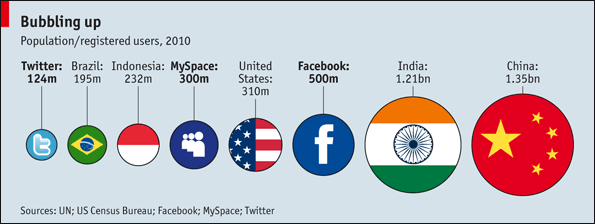It was a happy day for advertisers the world over when Facebook opened its ad platform. As of July 21st 2010, Facebook reached 500 million active users and 50% of these log on to Facebook on any given day. If Facebook were a country, it would be the third largest nation in the world, 500 billion minutes are spent on Facebook every month, so clearly, there are a lot of eyeballs at any time.
This diagram will show you just how big Facebook is:
We know that you would like to sell something to these users. Here’s something to get you started:
What is Facebook Ads?
Facebook Ads is a massive, easy to use and extremely tailored advertising platform that anyone can use to advertise on Facebook.
The platform was very loosely modelled on the very successful Google Ads model, with a few notable differences, one of which is that Facebook in and of itself is not a search engine. The ads on Facebook are, one may argue, somewhat social in nature.
Facebook owns a huge amount of data about each and every one of their users. Every single item a user puts into their profile, be it the name of a film/musical act they like, their marital status, their age, nationality, interests and anything else, all of those are potential ‘hooks’ with which a marketing message may be delivered to a relevant user. All the below options are offered as parameters which you can choose
- Location
- Age
- Gender
- Keywords
- Education
- Workplace
- Relationship Status
- Relationship Interests
- Languages
Personal example
When browsing Facebook in countries such as the UK and the US, or any other country with a high Internet penetration index, I never fail to notice the huge diversity of ads I get displayed to me. These ads are generated on the basis of what I put on my profile. I get ads for anything from tickets to films, to band merchandise, even for the most obscure of names.
Locally, few people truly know how to capture a Facebook audience, because such intense targeting is not evident.

Facebook. For more than just comments on photos.
OK, how do we do this?
Using generic data about your clientele, you can start drafting Facebook campaigns. You can choose to target the UK and Germany (for explanation purposes only). Examples below:
UK campaign targeting
● males + females
● age 35+
● any marital status
The above will give an audience of millions (Facebook allows one to see the numbers when creating the ad). Using this mildly targeted method, we would pay to have the ad displayed on people we know are relevant to our target audience, over 35s (have more money, mobility). Adding keywords here will target the ad further. For example, if you enter the term ‘metal’, you will have your ad displayed to metal workers or people involved in steel industries, but also to heavy metal fans. You will need to choose your keywords carefully.
Upon testing this out for a few days, we can see what is converting, and what is not, and tweak and optimise as necessary.
German campaign targeting
● males + females
● who speak Deutsch and English
● age 35+
● any marital status
This way, we shall target two markets, the English speaking market in Germany (small) and the German speaking market in Germany. Localising the ad works better in every scenario, however, one should not miss out the market potential offered by alternative languages in any home country.
Payment:
There are two types of paid online advertising. Affiliation is completely different and warrants an explanation in and of its own. One type of advertising is called CPC, the other CPM. CPC, or Cost Per Click, is exactly that, you bid a certain amount (say $0.75) on an advert (in Facebook’s case) and get charged around that amount every time a user clicks on the ad.
CPM, or Cost Per Mille, is the price you agree to pay for every thousand times that the ad is displayed, regardless of clicks.
In some cases, my suggestion would be to use CPC. My reasoning is that using CPC you can get huge amounts of ads displayed completely for free, while only paying a moderate price for the actual clicks. This way, you will only pay for people who have expressed their interest in your product by clicking on your ad.
Using CPC you can also use a generic rather than tailored ad (no keywords), therefore obtaining a much larger ‘catchment area’ for your ads to be displayed, while still paying only for clicks.
Budgeting:
Facebook only allows an advertiser to start off slow. However, if the campaigns perform well and one wishes to increase and escalate, you can very quickly reach the daily budget limit of $2000. The amount of impressions (times the ad is displayed) and clicks to the ad, and subsequently traffic to the sate and sales obtained by spending that kind of budget is gargantuan. Should your campaign be performing well and a larger daily expenditure than $2000 required, fear not, Facebook allows you to do that with a very simple process.
Operation:
Facebook provides all manner of data after about 28 hours of campaign start. This data will be of incredible help to optimise and further test other ads, as well as getting knowledge about each and every market. The platform allows one to pause, stop and cancel ads at any time, as well as start new ads or entire campaigns.

